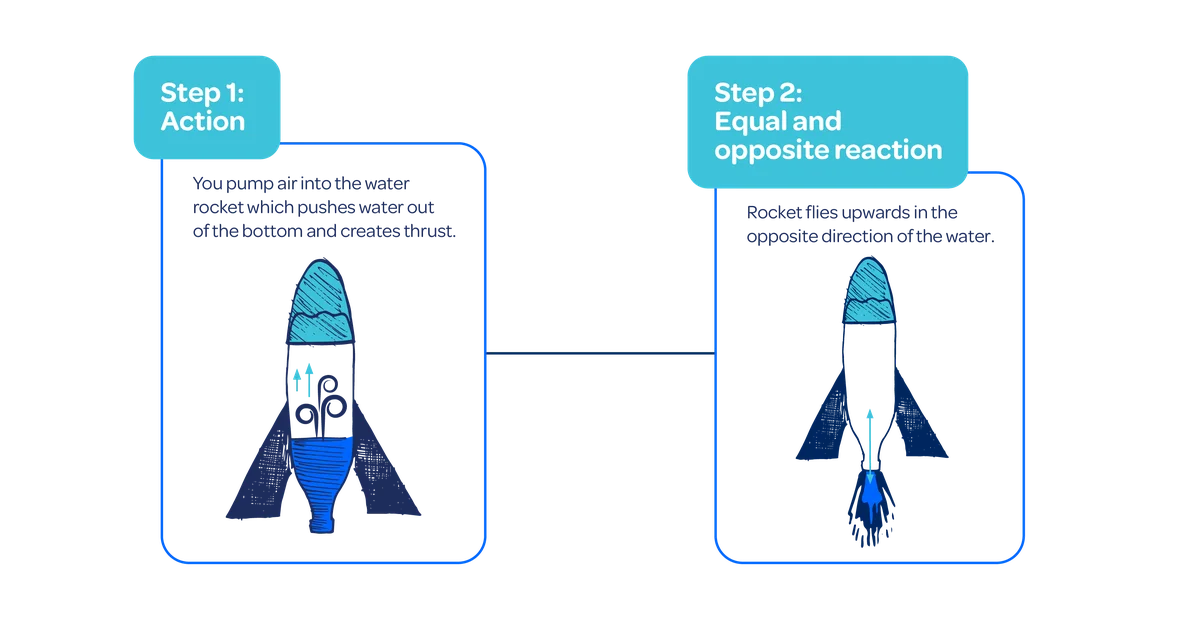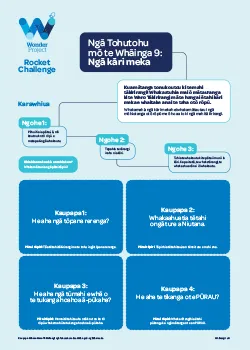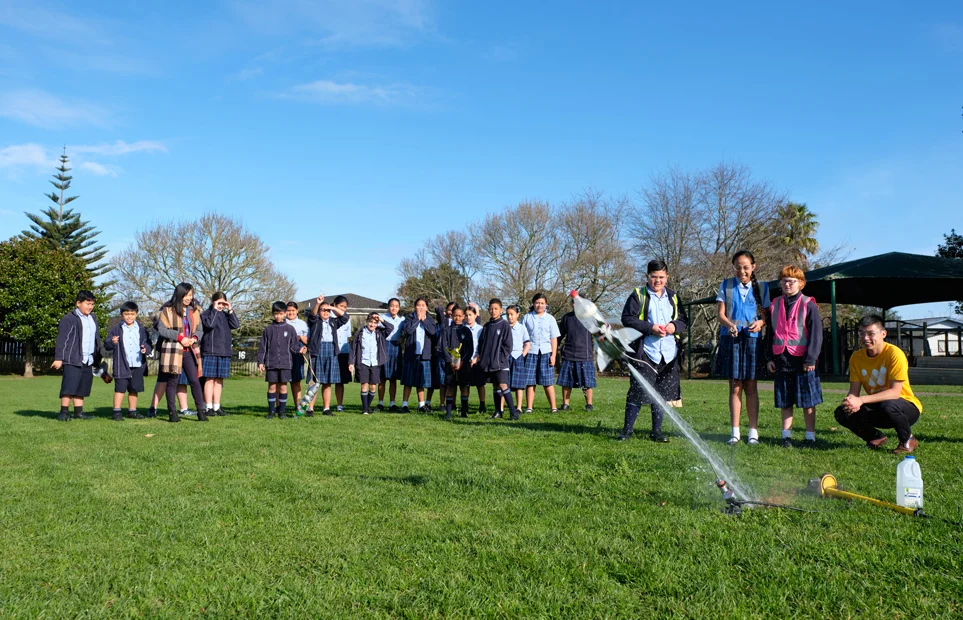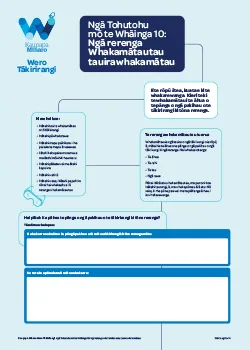

Module 5: Thrust
You’re about to become an expert on Newton’s final law of motion, how rockets get into space and what this has to do with thrust. Then, you’ll put your rocket prototypes to the test by performing your second test launch.
Newton’s third law
For every action there is an equal and opposite reaction

You can test this law in action with balloons. In your crew, blow up and release some balloons – whose balloon will go the furthest?
What does this have to do with thrust?
Remember, thrust is one of our forces of flight. It works in opposition to drag and weight to push your rocket into the air.
In real-life rockets, thrust is created by the rocket’s propulsion system (the engine) which launches the rocket into space.
In your rockets, it looks more like this…

Mission Brief 9: Fact card frenzy!
Now that you’ve learnt all of Newton’s laws, you’re almost expert rocketeers. Show off your Rocket Challenge knowledge by creating some handy fact cards to test your crew’s smarts.

Ngā tohutohu mō te Whāinga 9: Ngā kāri meka
Kua mātanga tonu koutou ki ngā mahi tākirirangi i tō mōhio ki ngā ture katoa a Niutana. Whakaaturia mai ō mātauranga ki te Wero Tākirirangi mā te hanga i ētahi kāri meka e whaitake ana hei whakamātau i ngā mōhiotanga o tō rōpū.

Prepare for launch!
Let’s send your rocket prototypes on their first mission! When STEM superstars make a rocket prototype, they test it thoroughly to figure out which parts of the rocket work well, and which parts need to be improved.
Your focus for this launch will be to observe how your prototypes fly and identify ways you could improve the design of your rockets.
Rocket aerodynamic design variables
To start, we need to think about the key design features a rocket needs to fly successfully. These could be things like the shape of your rocket’s fins, how heavy your rocket is, what material your rocket’s fins are made from, etc.
When testing your rocket’s aerodynamic design variables, you might want to think about:
- Strength and durability: Does your rocket prototype withstand the impact of the launch and landing? What would happen if it fell in water or mud?
- Safety and stability: Is your rocket balanced? Does it fly straight? Could your rocket cause harm to others by flying in the wrong direction?
- Efficiency and reliability: Does your rocket fly high and far? Will your rocket stay together for multiple test flights? What materials did you use?
Decide on one or two key aerodynamic design variables to observe. Your observations can help you evaluate how your prototype performed and what could be improved.
Before you head out to the launchpad, don’t forget to:
- Revise the health and safety rules
- Remind yourself of your crew role
- Assign someone to video your test flights
- Bring a copy of Mission Brief 10 and a pen to collect flight data!

Mission Brief 10: Prototype test flights
In your second round of test flights, observe how different aerodynamic design variables affect your rocket’s flight so you can try and make improvements. You’ll need all members of your crew on board to prepare for launch, remember to record results and video each launch performance.

Ngā tohutohu mō te Whāinga 10:
Ngā rerenga whakamātautau tauira whakamātau
I ngā rerenga whakamātautau tuarua nei, mātaihia te pānga o ngā āhuatanga hoahoa rerekē ki te rerenga o tō tākirirangi kia pai ai tō whakapai ake i te tākirirangi. Me mahi ngātahi te rōpū katoa ki te whakarite i te whakarewanga. Kia mahara koe ki te tuhi i ngā putanga me te whakaahua i ia whakarewanga.

Extra time to spare? You can plot your rocket’s trajectory to give you even more data on how to improve your prototype!
Trajectory is the actual or expected path your rocket follows as it moves through the sky.
Use one of the videos you took of your prototype to complete this optional activity:
Post-challenge survey
Nice work space crew – you’re almost at the end of the Rocket Challenge!
Make sure that after you’ve finished the challenge, you complete our post-challenge survey. You can tell us all the good bits, the bad bits and what you think could be better for next time.
Update your sticker chart!
Have you completed all the Mission Briefs for this module? Don’t forget to put a sticker on your chart!
Module 5 checklist
- Watched: Newton's third law
- Learned about thrust
- Completed Mission Brief 9: Fact cart frenzy!
- Completed Mission Brief 10: Prototype test flights
Optional – Measuring trajectory activity
Ready for the next step?